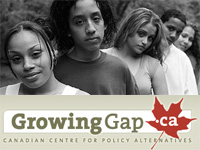This is an archive of news stories and research from the National Union of Public and General Employees. Please see our new site - https://nupge.ca - for the most current information.
Gap widest in 30 years even though the poor are working harder than ever
 Toronto (4 March 2007) - The National Union of Public and General Employees says a new study by the Canadian Centre for Policy Alternatives (CCPA) on the growing gap between rich and poor should be required reading for all public policy makers in Canada.
Toronto (4 March 2007) - The National Union of Public and General Employees says a new study by the Canadian Centre for Policy Alternatives (CCPA) on the growing gap between rich and poor should be required reading for all public policy makers in Canada.
The report, entitled The Rich and the Rest of Us: The Changing Face of Canada's Growing Gap, shows that while 80% of all Canadian families are working harder than ever, they are getting an ever smaller share of the country's economy and are falling even farther behind the elite and comfortable group at the top.
Authored by Armine Yalnizyan, the study finds Canada's income gap between the rich and poor is worsening for the very reasons that have often been cited in the past. The lion's share of economic growth is going to the richest 10% of Canadian families, not to the majority - the 80% of families earning under $100,000 a year.
"Canada's gap is growing at a time when Canadian families are playing by all the rules - working harder, contributing to a growing economy - but most aren't getting payback," says Yalnizyan.
The new research focuses on the earnings and after-tax incomes of Canadian families raising children under 18. It compares situations faced by families in the late 1970s to those in the early 2000s. Among the findings:
- The gap just grows wider: In 2004, the richest 10% of families earned 82 times more than the poorest 10%, almost triple the ratio of 1976, when they earned 31 times more. In after-tax terms the gap is at a 30-year high.
- The bottom half is being shut out. Between 1976-79 the bottom half earned 27% of total earnings. Between 2001-04 that dropped to 20.5%, although they worked even harder. Up to 80% of families lost ground or stayed put compared to the previous generation, in both earnings and after-tax terms. The poorest saw real incomes (discounted for inflation) drop.
- Work is not enough: All but the richest 10% of families are working more weeks and hours in the paid workforce (200 hours more a year on average since 1996) yet only the richest 10% saw a significant increase in their earnings - 30%.
To get the full report, visit this page at the Canadian Centre for Policy Alternatives website: www.growinggap.ca NUPGE
